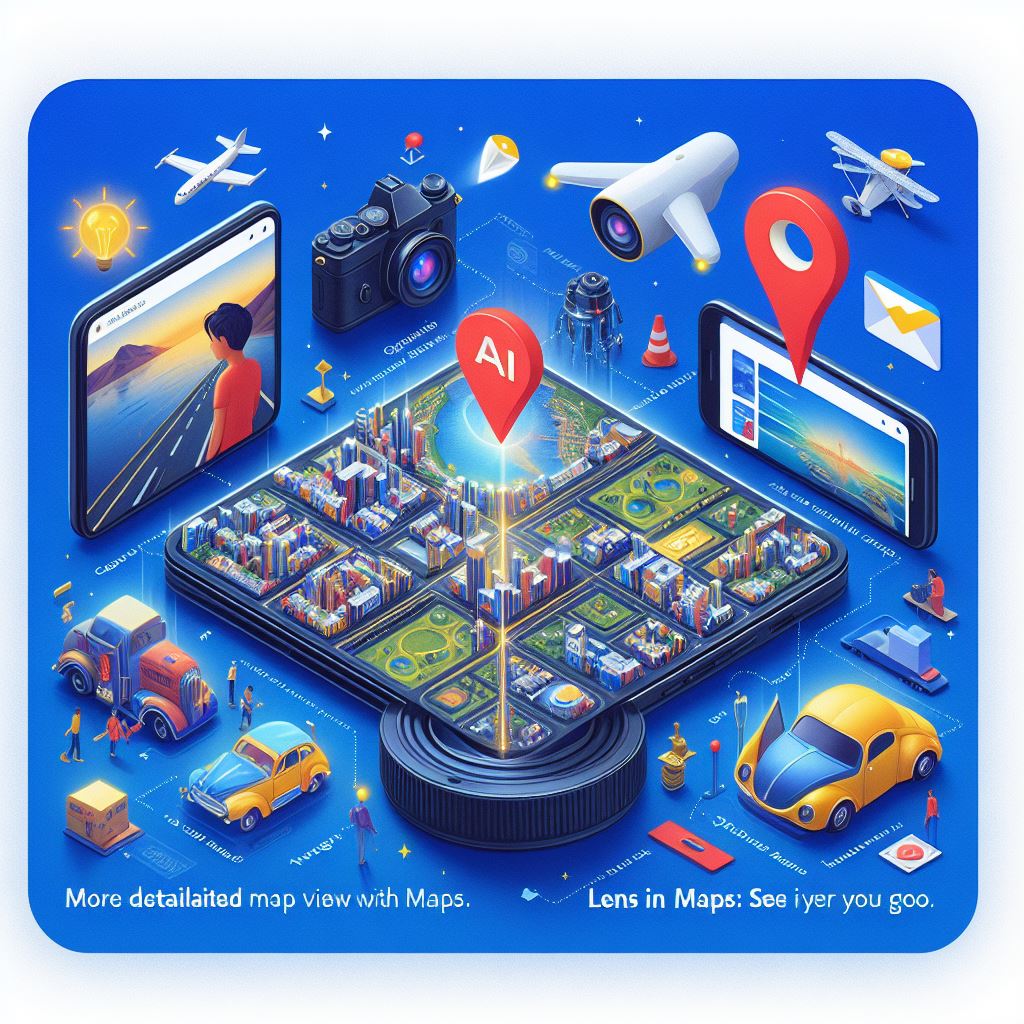Introduction: Revolutionizing Navigation with AI
In the fast-evolving landscape of digital navigation, Google Maps stands at the forefront, integrating artificial intelligence to transform user experiences. The infusion of AI isn’t merely a technological leap; it’s a paradigm shift that enhances navigation in ways previously unimagined.
- Introduction: Revolutionizing Navigation with AI
- Immersive View: Redefining Your Journey
- AI-Powered 3D Maps
- Real-Time Traffic and Weather Updates
- AI-Powered 3D Maps
- Lens in Maps: Augmented Reality at Your Fingertips
- Exploring Surroundings via AR
- Informational Insights via Camera
- Exploring Surroundings via AR
- More Detailed Maps: AI’s Role in Realism
- Enhanced Realistic Map Views
- Beyond Traffic: Detailed Structures
- Enhanced Realistic Map Views
- New Ariel View API: Transforming Perspectives
- Bringing 3D Birds-Eye Views
- AI Extraction from Street and Aerial Images
- Bringing 3D Birds-Eye Views
- Photo-First Results: AI-Driven Precision: Advanced Image Recognition for Seamless Exploration
- How AI Transforms Google Maps: Revolutionizing User Experience
- AI Integration: Enhancing User Accessibility: Accessibility and User-Friendly Design
- Privacy Concerns and AI: Balancing Innovation with Privacy
- Future Prospects: AI’s Evolution in Maps: Anticipating Further AI Advancements
- AI’s Impact on Travel and Business: Revolutionizing Travel and Commerce
- The Human Touch in an AI World: Finding Harmony between AI and Human Interaction
- AI Adoption and User Adaptation: User Acceptance and Adaptation
- The Ethical Discourse around AI Integration: Ethical Implications of AI in Maps
- Conclusion: Embracing AI-Powered Navigation: Embracing the AI Era in Navigation

Immersive View: Redefining Your Journey
In the quest for redefining journeys, Google Maps introduces Immersive View, a game-changer powered by AI-generated 3D maps. Imagine previewing every turn and intersection, thanks to real-time updates on traffic and weather conditions. This feature isn’t just about directions; it’s about informed decisions, enabling users to choose the best routes.
Lens in Maps: Augmented Reality at Your Fingertips
The lens in Maps brings forth an extraordinary fusion of AI and augmented reality, unlocking a trove of information. Simply point your camera at places of interest – ATMs, transit stations, eateries, and shops – and watch as AI reveals pertinent details, making exploration an interactive and insightful experience.
More Detailed Maps: AI’s Role in Realism
AI isn’t just improving routes; it’s enhancing the very fabric of maps. Google Maps, infused with AI, goes beyond traffic updates, offering lifelike structures and intricate details, mirroring the real world. The integration of AI provides users with a heightened sense of place and context.
New Ariel View API: Transforming Perspectives
With the introduction of the New Ariel View API, Google Maps reaches new heights. This API, powered by AI, delivers stunning 3D bird’s-eye views while employing advanced algorithms to identify and extract objects from street-level and aerial images. It’s a revolution in perspective.
Photo-First Results: AI-Driven Precision
Enter a new era where AI and advanced image recognition algorithms assist in finding precise locations effortlessly. Google Maps leverages AI models to offer photo-first results, ensuring that what you see is what you get, empowering users with accurate destination previews.
How AI Transforms Google Maps
The integration of AI isn’t merely about enhancing features; it’s about revolutionizing the user experience. It’s about more than navigation; it’s providing users with a personalized, detailed, and intuitive journey.
AI Integration: Enhancing User Accessibility
Accessibility takes center stage as AI-driven enhancements make navigation more user-friendly for all. Through intuitive interfaces and personalized suggestions, Google Maps becomes a tool accessible to everyone, regardless of expertise.
Privacy Concerns and AI
As AI permeates our digital experiences, concerns about data privacy emerge. Google Maps acknowledges these concerns, maintaining a balance between innovation and privacy, ensuring user data remains secure while leveraging AI capabilities.
Future Prospects: AI’s Evolution in Maps
The AI integration in Google Maps is just the beginning. Anticipate further advancements that will push the boundaries of navigation, making it even more personalized, seamless, and efficient.
AI’s Impact on Travel and Business
Beyond navigation, AI’s integration in Maps holds profound implications for travel and commerce. It reshapes how businesses are discovered and how travelers explore, paving the way for new opportunities and efficiencies.
The Human Touch in an AI World
While AI enhances navigation, preserving the human touch remains pivotal. Balancing AI-driven precision with human interaction ensures a holistic and enriching navigation experience.
AI Adoption and User Adaptation
AI adoption necessitates user adaptation. Google Maps aims to bridge this gap, easing users into the realm of AI-driven navigation through intuitive interfaces and the gradual introduction of new features.
The Ethical Discourse around AI Integration
Ethical considerations accompany AI integration. Google Maps acknowledges the importance of ethical discourse, ensuring responsible AI utilization and considering the societal impact of these advancements.
Conclusion: Embracing AI-Powered Navigation
In conclusion, the infusion of AI within Google Maps marks a seismic shift in navigation technology. It’s not just about reaching destinations; it’s about experiencing the journey in a more informed, immersive, and personalized manner.
FAQs
1. Will these AI-powered features be available globally on Google Maps? These features are progressively rolled out globally, aiming to reach all users eventually.
2. How does Google ensure the privacy of user data while employing AI in Maps? Google employs stringent privacy measures, anonymizing data and using encryption to safeguard user information.
3. Can AI-powered features work offline? Some features might work partially offline, but optimal functionality requires an internet connection.
4. Are there plans to introduce more AI-driven functionalities in Google Maps? Google is constantly innovating; thus, expect new AI-driven features in future updates.
5. How can businesses leverage AI integration within Google Maps? Businesses can optimize their presence on Maps by ensuring accurate information and utilizing Google’s business tools for better visibility.
This comprehensive integration of AI within Google Maps sets a new standard for navigation, blending technology and human-centric design to offer a truly remarkable experience for users worldwide.
